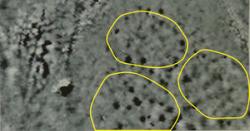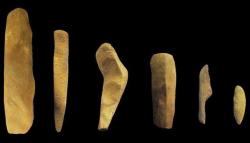INSTITUT SUPERIEUR D'ANTHROPOLOGIE
INSTITUTE OF ANTHROPOLOGY
ONLINE COURSES / COURS A DISTANCE
FALL TERM : OCTOBER 2015
REGISTER NOW
USA –  Arkansas City - Wichita State University professor Don Blakeslee says a recent archaeological dig in south-central Kansas has yielded evidence of a Native American settlement dating back more than 400 years. He says researchers found iron and lead balls that are the same type of ammunition shot from cannons and muskets by Spanish conquistadors who explored the Great Plains in the 16th and 17th centuries. Blakeslee says the evidence supports his theory that Arkansas City is the site of the 5-mile-long town of Etzanoa, which was inhabited by about 20,000 ancestors of the Wichita Indians about 400 years ago. They said they also toured the lower Walnut River areas with Blakeslee last summer. "It was a feeling kind of thing, to imagine 20,000 of our people living here," Parton said.
Arkansas City - Wichita State University professor Don Blakeslee says a recent archaeological dig in south-central Kansas has yielded evidence of a Native American settlement dating back more than 400 years. He says researchers found iron and lead balls that are the same type of ammunition shot from cannons and muskets by Spanish conquistadors who explored the Great Plains in the 16th and 17th centuries. Blakeslee says the evidence supports his theory that Arkansas City is the site of the 5-mile-long town of Etzanoa, which was inhabited by about 20,000 ancestors of the Wichita Indians about 400 years ago. They said they also toured the lower Walnut River areas with Blakeslee last summer. "It was a feeling kind of thing, to imagine 20,000 of our people living here," Parton said.
http://kmuw.org/post/arkansas-city-archaeology-shows-evidence-ancient-town
INDE –  Kaprikkad - The tools, identified as being made of dyke dolerite, had heavy flake scars and were coated with layers of mud. Only on scrapping off of the mud did the shape of the tools emerge, said the official. These tools will be examined by experts on Neolithic stone tools for final confirmation. “This is the first time that we have come across stone tools of such vintage in the primary context,” said the official, who pointed out that the area marked out for excavation might have been a habitation 4,000 to 5,000 years ago.The stone tools were found on a mount within the Kaprikkad forests.
Kaprikkad - The tools, identified as being made of dyke dolerite, had heavy flake scars and were coated with layers of mud. Only on scrapping off of the mud did the shape of the tools emerge, said the official. These tools will be examined by experts on Neolithic stone tools for final confirmation. “This is the first time that we have come across stone tools of such vintage in the primary context,” said the official, who pointed out that the area marked out for excavation might have been a habitation 4,000 to 5,000 years ago.The stone tools were found on a mount within the Kaprikkad forests.
http://www.nyoooz.com/kochi/127804/excavation-planned-in-kaprikkad
CHINE –  Yuanmingyuan - The 800-square-meter archaeological site at the ruins of the Western Pavilion in Yuanmingyuan, or the Old Summer Palace, has been opened to the public so that people can observe how archaeologists do their work. In the future, people will be able to sign up for archaeology workshops, the Beijing News reported. The Western Pavilion was built during the Qing Dynasty (1644-1911) and in a Western architectural style. It was destroyed during the invasion of the Eight-Power Allied Forces, so now archaeologists are working to unearth the ruins to learn more about its overall layout. An official with the Beijing Municipal Bureau of Culture said the site will be open all year round.
Yuanmingyuan - The 800-square-meter archaeological site at the ruins of the Western Pavilion in Yuanmingyuan, or the Old Summer Palace, has been opened to the public so that people can observe how archaeologists do their work. In the future, people will be able to sign up for archaeology workshops, the Beijing News reported. The Western Pavilion was built during the Qing Dynasty (1644-1911) and in a Western architectural style. It was destroyed during the invasion of the Eight-Power Allied Forces, so now archaeologists are working to unearth the ruins to learn more about its overall layout. An official with the Beijing Municipal Bureau of Culture said the site will be open all year round.
INDE –  Mauxi - Mauxi, known for its rock-carving heritage, jumped into the limelight again as locals discovered more cupule slabs there. For more than a decade, historians and archaeologists knew Mauxi for rock carvings of zebus, bulls, antelopes and other animals. A cupule slab was discovered when a villager Dnyaneshwar Gaonkar was carrying out an excavation according to a dream, in which he saw the wealth buried in front of the rock, which had carvings of a trident and antelope. After unearthing clay, sand, and pebbles from the river bed, they found oval-shaped hollows in the rock slab, which was on the rivulet’s right bank. The hollows were around 50-60 centimeters deep. When contacted, former archaeology director Prakashchandra Shirodkar said, “The Mauxi rock-carving site belongs to the Neolithic period. Recently, stone tools and implements were discovered near the carving of the bull-fight. There is an urgent need to systematically and scientifically excavate this site as it will reflect the facets of heritage unknown to us. Carvings of bulls, a dancing girl and also cupules have been discovered recently in the area.”Cupule slabs were found in around seven spots. Cupules are circular hollows on the surface of a rock. They represent fluvial abrasion hollows created by the scouring action of rocks and pebbles in moving water. So far, no Paleolithic expert has given a convincing explanation of the cupules’ cultural or artistic meaning. Of the current theories, most associate cupules with fertility rites, or ‘increase ceremonies’.
Mauxi - Mauxi, known for its rock-carving heritage, jumped into the limelight again as locals discovered more cupule slabs there. For more than a decade, historians and archaeologists knew Mauxi for rock carvings of zebus, bulls, antelopes and other animals. A cupule slab was discovered when a villager Dnyaneshwar Gaonkar was carrying out an excavation according to a dream, in which he saw the wealth buried in front of the rock, which had carvings of a trident and antelope. After unearthing clay, sand, and pebbles from the river bed, they found oval-shaped hollows in the rock slab, which was on the rivulet’s right bank. The hollows were around 50-60 centimeters deep. When contacted, former archaeology director Prakashchandra Shirodkar said, “The Mauxi rock-carving site belongs to the Neolithic period. Recently, stone tools and implements were discovered near the carving of the bull-fight. There is an urgent need to systematically and scientifically excavate this site as it will reflect the facets of heritage unknown to us. Carvings of bulls, a dancing girl and also cupules have been discovered recently in the area.”Cupule slabs were found in around seven spots. Cupules are circular hollows on the surface of a rock. They represent fluvial abrasion hollows created by the scouring action of rocks and pebbles in moving water. So far, no Paleolithic expert has given a convincing explanation of the cupules’ cultural or artistic meaning. Of the current theories, most associate cupules with fertility rites, or ‘increase ceremonies’.
http://www.heraldgoa.in/Goa/North-Goa/On-treasure-hunt-villager-stumbles-on-wealth-of-heritage-in-Mauxi/89759.html